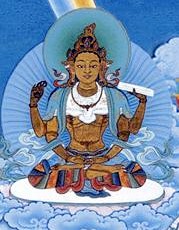Six mother scriptures: Difference between revisions
Jump to navigation
Jump to search
mNo edit summary |
No edit summary |
||
| Line 1: | Line 1: | ||
[[Image:Prajnaparamita.jpg|frame|The goddess [[Prajñaparamita]]]] | [[Image:Prajnaparamita.jpg|frame|The goddess [[Prajñaparamita]]]] | ||
'''Six mother scriptures''' (Tib. | '''Six mother scriptures''' (Tib. ཡུམ་དྲུག, ''yum druk'', [[Wyl.]] ''yum drug'') — of the [[Seventeen mothers and sons|seventeen sutras]] upon which the [[Abhisamayalankara]] is a commentary, these are the ones which fully reveal the [[eight topics]].<ref>[[Khenpo Tsöndrü]] says, "Regarding the criteria for classifying these as either ‘mother’ or ‘son’ scriptures, sutras revealing the [[eight topics|eight clear realizations]] are termed ‘mother’ scriptures, whilst those revealing them only partially are termed [[eleven son scriptures|‘son’]]."[http://www.lotsawahouse.org/prajnaparamitaprelim.html]</ref> | ||
#[[Perfection of Wisdom Sutra in One Hundred Thousand Lines|Sutra in One Hundred Thousand Lines]] (''Shatasahasrika'') | #[[Perfection of Wisdom Sutra in One Hundred Thousand Lines|Sutra in One Hundred Thousand Lines]] (''Shatasahasrika'') | ||
Revision as of 04:32, 27 January 2018

Six mother scriptures (Tib. ཡུམ་དྲུག, yum druk, Wyl. yum drug) — of the seventeen sutras upon which the Abhisamayalankara is a commentary, these are the ones which fully reveal the eight topics.[1]
- Sutra in One Hundred Thousand Lines (Shatasahasrika)
- Sutra in Twenty-five Thousand Lines (Pañcavimshatisahasrika)
- Sutra in Eighteen Thousand Lines (Ashtadashasahasrika)
- Sutra in Ten Thousand Lines (Dashasahasrika)
- Sutra in Eight Thousand Lines (Ashtasahasrika)
- Verse Summary (Saṃchaya)
Notes
- ↑ Khenpo Tsöndrü says, "Regarding the criteria for classifying these as either ‘mother’ or ‘son’ scriptures, sutras revealing the eight clear realizations are termed ‘mother’ scriptures, whilst those revealing them only partially are termed ‘son’."[1]